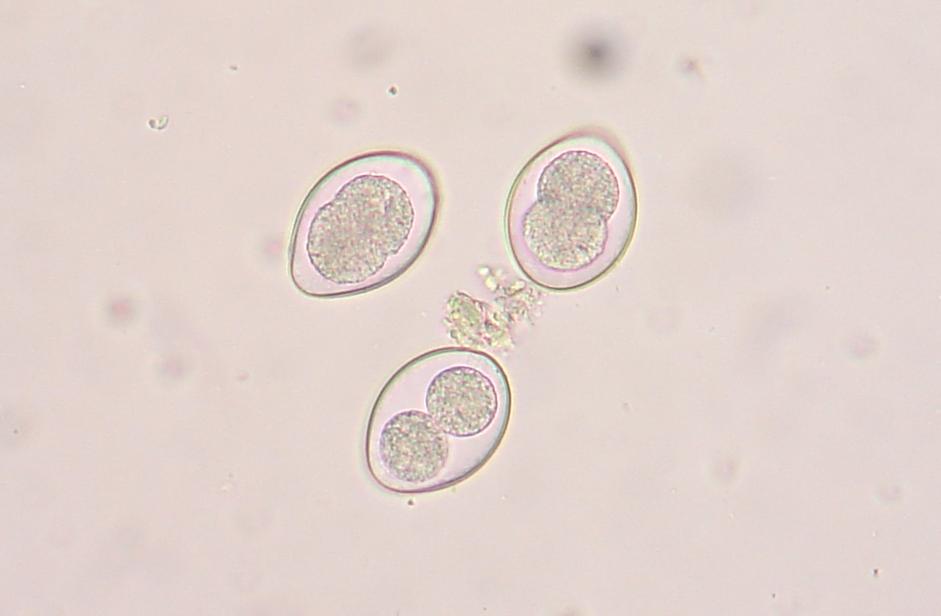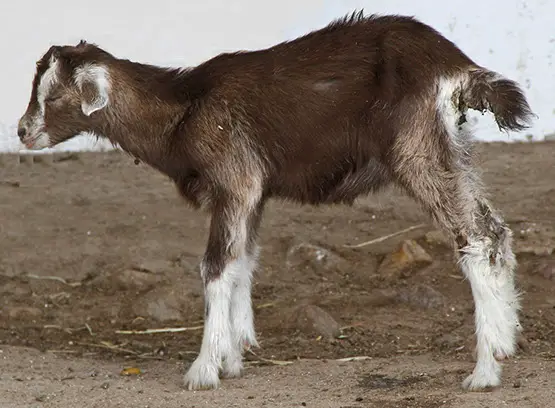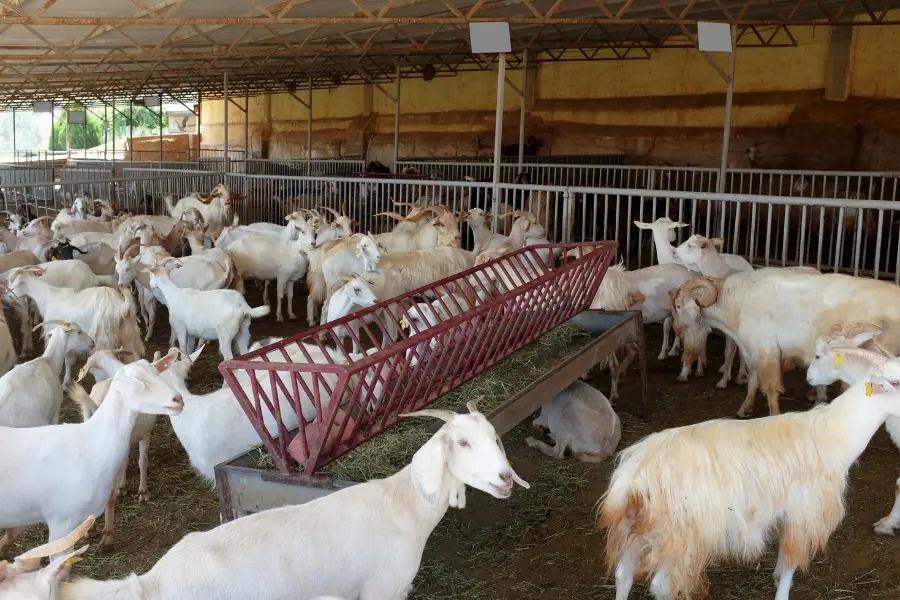Coccidiosis is a parasitic disease commonly found in goats, significantly affecting their productivity, growth, and overall health. It is caused by the protozoan parasite from the genus Eimeria and primarily affects the gastrointestinal tract of goats, leading to diarrhea, poor weight gain, and in severe cases, death. Understanding coccidiosis is key to improving goat health and productivity in both small and large farms.
Table of contents
- Understanding Coccidiosis
- Coccidiosis in Goats: A Historical Perspective
- Early Recognition
- Discovery of the Coccidian Parasites
- Development of Anticoccidial Drugs
- Coccidiosis in Goats – Present and Future
- Coccidiosis Symptoms
- Diagnosis
- Prevention and Control of Coccidiosis in Goats
- Treatment of Coccidiosis in Goats
- WARNING: No Drugs that treat Coccidiosis are FDA Approved for use In Goats
- Amprolium: A Vital Anticoccidial Drug
- Toltrazuril: An Effective Treatment for Coccidiosis
- Sulfonamides: Broad Spectrum Antibiotics in the Battle Against Coccidiosis
- Video- Official Video from Oklahoma State University
- Conclusion
- FAQs
Understanding Coccidiosis
Coccidiosis is the result of an infection by parasite . It is primarily transmitted through the fecal-oral route when goats consume feed or water contaminated with fecal matter containing oocysts (a stage in the life cycle of coccidia).
These oocysts are resistant to harsh environmental conditions, enhancing their survival rate. Once ingested, the oocysts undergo sporulation in the goat’s intestinal tract, which leads to the release of sporozoites that invade the intestinal cells, resulting in tissue damage and clinical disease.
Coccidiosis in Goats: A Historical Perspective
The history of coccidiosis in goats, much like that of many livestock diseases, is deeply intertwined with the history of animal domestication, agriculture, and the advancement of veterinary science.
Early Recognition
The disease was likely present as long as goats have been domesticated, which dates back roughly 10,000 years. However, the specific understanding and identification of coccidiosis as a distinct disease entity is relatively recent, only occurring in the last few centuries.
In the early days, the symptoms of coccidiosis might have been recognized, but the cause would have been unknown. Diarrhea, poor growth, and high mortality, particularly in young animals, would have been a cause of concern for goat herders, but without the necessary scientific understanding or technology, the actual cause would have remained a mystery.

Discovery of the Coccidian Parasites
The advent of microscopy in the 17th century revolutionized our understanding of microscopic organisms, leading to the discovery of many parasites. However, it wasn’t until the late 19th and early 20th centuries that the protozoan parasites causing coccidiosis were formally identified and studied.
Veterinary scientists were able to examine fecal samples under microscopes, leading to the discovery of the Eimeria oocysts responsible for coccidiosis. However, understanding the life cycle of these parasites and their role in causing disease took more time and research.
Coccidiosis Terminology
- Coccidiosis is the name of the disease in goats that is caused by several species of Eimeria.
- Coccidia is the subclass grouping of parasites that contains the genus Eimeria and its various species
- Eimeria species are a type of Coccidia that causes the disease Coccidiosis
- Oocysts are spores that have a hard shell and a long life cycle. They remain dormant until they enter the digestive tract of an animal. There, they reproduce, cause the disease coccidiosis, and create more spores. The animal releases the spores in its feces.
Development of Anticoccidial Drugs
With the rise of intensive farming practices in the 20th century, the control of coccidiosis became even more critical due to the increased risk of disease spread in crowded conditions.
The first anticoccidial drugs, including sulfonamides, were introduced in the mid-20th century. These drugs had a broad-spectrum activity against various bacteria and protozoan parasites and made a significant difference in managing coccidiosis. The later part of the 20th century saw the introduction of more targeted anticoccidial drugs like amprolium and toltrazuril, providing more effective treatment options.
Coccidiosis in Goats – Present and Future
Today, our understanding of coccidiosis in goats is more comprehensive than ever. Yet, it remains a significant challenge, particularly for intensive farming systems. The development of drug resistance is an ongoing concern, necessitating judicious use of anticoccidial drugs and highlighting the importance of preventative measures, such as good hygiene practices and nutrition management.
Looking forward, research continues to explore more effective and sustainable ways to manage coccidiosis, including the development of vaccines and natural treatments, better understanding of goat immunity to coccidiosis, and improvement of goat housing and management systems to reduce disease risk.
Coccidiosis Symptoms

Signs of coccidiosis typically manifest two to three weeks after infection. The primary symptom is diarrhea, which can range from mild to severe, often accompanied by blood or mucus. Other signs include weight loss, poor growth, dehydration, reduced appetite, anemia, and abdominal discomfort. In severe cases, the disease may cause death, especially in younger goats with underdeveloped immune systems.
Diagnosis
Accurate diagnosis of coccidiosis involves analyzing fecal samples under a microscope to identify and count the oocysts. A higher-than-normal oocyst count indicates coccidiosis. However, keep in mind that the mere presence of oocysts does not always signify disease, as some oocysts are part of the normal flora in the gut of goats.
Prevention and Control of Coccidiosis in Goats
The best way to manage coccidiosis in goats is by implementing preventative measures and sound management practices.
Sanitation
Maintaining clean and dry living quarters reduces the likelihood of coccidia transmission. Regularly clean feeders and waterers to prevent fecal contamination.
Overcrowding
Overcrowding increases the chances of coccidiosis transmission. Ensuring sufficient space per goat can minimize disease transmission.
Nutrition
Adequate nutrition helps to boost the goat’s immune system, enabling them to better fight off infections.
Quarantine
Newly purchased animals should be quarantined and tested to prevent introducing coccidiosis into a healthy herd.
Coccidiostats
Coccidiostats are drugs that can be used as feed additives. They can prevent coccidiosis in goats. These drugs do not kill the coccidial organisms, but instead keep it from becoming widespread.
FDA approved drugs for goats are deconquinate (common brand name Deccox) and monensin (common brand name Rumensin). Dosing of both drugs are based on body weight.
WARNINGS about Coccidiostats
- Monensin (Rumensin) and deconquinate (Deccox) only use used with non-lactating goats.
- Monensin (Rumensin) is very toxic if mixed incorrectly
- Monensin (Rumensin) is highly toxic to horses and dogs
It is advisable to use Coccidiostats under the guidance of your trusted veterinarian.

Treatment of Coccidiosis in Goats
Treatment of coccidiosis involves using anticoccidial drugs such as amprolium, toltrazuril, or sulfonamides. These drugs inhibit the growth and reproduction of the coccidia parasite, providing symptomatic relief. Along with medication, supportive care including rehydration therapy and proper nutrition is crucial.
However, it is important to note that while treatment helps reduce symptoms, it does not eliminate the parasites entirely. Hence, management strategies must be geared towards prevention and building the goat’s natural immunity against coccidiosis.
IMPORTANT: Always heed with withdrawal times for meat and milk.
WARNING: No Drugs that treat Coccidiosis are FDA Approved for use In Goats
Toltrazuril is NOT FDA approved for any animal in the United States. It is legal in other countries – check your local laws.
Aprolium and some sulfonamides are FDA approved for some animals, and so treating goats with these drugs is an extra label (off label use)
Per Cornell University: “The FDA regards extra-label use of drugs as an exclusive privilege of the veterinary profession and is only permitted when a bona fide veterinarian-client-patient relationship exists and an appropriate medical diagnosis has been made.”
Amprolium: A Vital Anticoccidial Drug
Amprolium is a widely used anticoccidial drug for the treatment of coccidiosis in various livestock. It was developed in the 1960s and has become one of the leading treatments for this disease due to its efficacy and safety profile.
Treating goats with Amprolium in considered an extra-label use, and treatment with this drug can only occur under the guidance of a licensed veterinarian.
Mechanism of Action
Amprolium functions by mimicking thiamine (vitamin B1), which is essential for the growth and multiplication of coccidian parasites. It competitively inhibits thiamine uptake by the coccidia, depriving them of this vital nutrient, thereby suppressing their ability to reproduce and grow. Importantly, amprolium does not kill the coccidia directly; instead, it inhibits their proliferation, allowing the host animal’s immune system to manage the infection more effectively.
Dosage and Administration
Amprolium is typically administered orally, either through drinking water or mixed with feed. The dosage varies based on the severity of the infection and the type of livestock, but it should always be given under the direction of a veterinarian. Overdosing or underdosing can lead to ineffective treatment and potential complications. It’s important to note that during treatment with amprolium, supplementary thiamine should not be administered to the goats as it can counteract the drug’s efficacy.
Safety and Side Effects
Amprolium is generally considered safe when administered correctly. However, as it competes with thiamine, prolonged use or overdose can lead to thiamine deficiency in the host animal, leading to conditions such as polioencephalomalacia, (Goat Polio) a serious neurological disease. Thus, it’s crucial to follow the appropriate dosage and treatment duration.
Amprolium Summary
Amprolium stands as a valuable tool in the fight against coccidiosis. However, using it to treat coccidiosis in goats can only occur under professional guidance. And while treatment is important, a robust approach to coccidiosis should still prioritize preventive measures, including good sanitation, feeding practices, and regular monitoring for early detection of the disease.
Toltrazuril: An Effective Treatment for Coccidiosis
Toltrazuril is NOT FDA approved for any animal in the United States. It is legal in other countries. Check your local laws.
Toltrazuril is a potent anticoccidial drug often utilized in veterinary medicine for the management of coccidiosis in various animals. Unlike some other treatments, toltrazuril is effective against all intracellular stages of coccidia, making it a valuable weapon in the battle against this disease.
Mechanism of Action
Toltrazuril works by disrupting the nuclear division and wall-forming bodies of coccidian parasites during their intracellular development, resulting in a disruption of their life cycle. Unlike amprolium, toltrazuril does not interfere with the host’s metabolism, focusing instead on directly damaging the parasites at multiple developmental stages.
Dosage and Administration
Toltrazuril is administered orally, usually as a single dose, and is often provided in a suspension form for ease of use. Needing just a single dose is one of the advantages of this drug. The dosage should be determined by a veterinarian, considering the weight of the animal and the severity of the infection. Regular fecal checks should be conducted following treatment to ensure the efficacy of the drug.
Safety and Side Effects
In locations where it is legal, Toltrazuril has a good safety profile and is well-tolerated in goats. However, it’s essential to use the drug responsibly to avoid potential resistance in the future. Overuse of anticoccidial drugs can lead to drug-resistant strains of coccidia, which pose a significant challenge for goat farmers and vets alike.
Toltrazuril does not have many side effects, and the goats usually tolerate it well. However, as with all medications, there can be instances of individual sensitivities or allergic reactions, though these are uncommon.
It has a long withdrawal time – 48 days for lambs.
Toltrazuril Summary
Toltrazuril is a crucial part of the toolkit for managing coccidiosis in goats, in countries where it is legal. It acts against all stages of the parasite offering a broad level of control over the disease. As always, prevention is better than cure, and responsible management practices should accompany the use of drugs like toltrazuril to maintain a healthy goat population. Despite its effectiveness, toltrazuril, like all anticoccidials, should be used judiciously under professional guidance to prevent the development of drug resistance.
Sulfonamides: Broad Spectrum Antibiotics in the Battle Against Coccidiosis
Sulfonamides are a class of antimicrobial drugs widely used in veterinary medicine, including in the treatment of coccidiosis. Known for their broad-spectrum antibiotic properties, sulfonamides are effective against a range of bacteria and some protozoan parasites, including coccidia.
Using sulfonamides in goats in considered an extra-label use, and treatment with these drugs can only occur under the guidance of a licensed veterinarian.
Mechanism of Action
Sulfonamides inhibit the growth of bacteria and some parasites by interfering with the synthesis of folic acid, a vital component needed for their replication and survival. These drugs work by mimicking a substrate (para-aminobenzoic acid, or PABA) needed for folic acid production, thus acting as competitive inhibitors for the enzyme responsible for folic acid synthesis. This disruption of the metabolic pathway stunts the growth and reproduction of the organisms.
Dosage and Administration
The dosage and administration of sulfonamides depend on the specific drug used, the severity of the infection, and the animal’s size and overall health. They are typically administered orally and should always be given under the guidance of a veterinarian to ensure appropriate treatment and prevent potential complications.
Safety and Side Effects
While generally safe, sulfonamides can have side effects, including allergic reactions, photosensitivity, and gastrointestinal upset. Kidney damage can also occur, particularly if the animal becomes dehydrated, so adequate water intake during treatment is crucial.
Due to their broad-spectrum action, sulfonamides can also affect the normal gut flora, potentially leading to digestive upset or secondary yeast infections. As a result, it’s important to monitor the health of goats closely during and after treatment.
Resistance to Sulfonamides
One key concern with sulfonamides, as with other antimicrobials, is the potential for the development of resistance. Overuse or misuse of these drugs can lead to the emergence of resistant strains of bacteria or parasites, reducing the drugs’ effectiveness. Thus, it’s crucial to use these medications responsibly and typically as a last resort.
Sulfonamides Summary
Sulfonamides serve as a vital tool in treating coccidiosis in goats. However, they can only be administered under the guidance of a licensed veterinarian. Their use should be approached judiciously due to the potential for side effects and the development of drug resistance. As always, good management practices are the bedrock of preventing coccidiosis, with antimicrobial drugs serving as a supportive tool when necessary.
Video- Official Video from Oklahoma State University
Dr. Gener Parker, veterinarian from OSU, presents in his direct, affable style about goat diseases. Skip directly to 40:29 to learn about Coccidiosis in Goats.
Conclusion
Coccidiosis poses a significant threat to goat health and productivity. Farmers and goat owners need to be aware of the signs and symptoms of this disease, and take appropriate measures to prevent, control, and treat the condition. By implementing good hygiene and management practices, reducing stress and providing balanced nutrition, the impact of coccidiosis on goats can be substantially minimized.
FAQs
There are no FDA approved drugs to treat Coccidiosis in goats. Some drugs can be used off-label, with veterinarian supervision. Drugs for Coccidiosis prevention, deconquinate and monensin are approved by the FDA.
Kids goats that have just been weaned are the most susceptible to Coccidiosis.
Coccidia spores are widespread, live a long time, and so most goats harbor some of the spores. But they don’t always get sick.
Prevention is key. Keep the living quarters clean and dry. Don’t crowd the goats, and give them adequate nutrition. Quarantine any ill goats, and use Coccidiostats.




